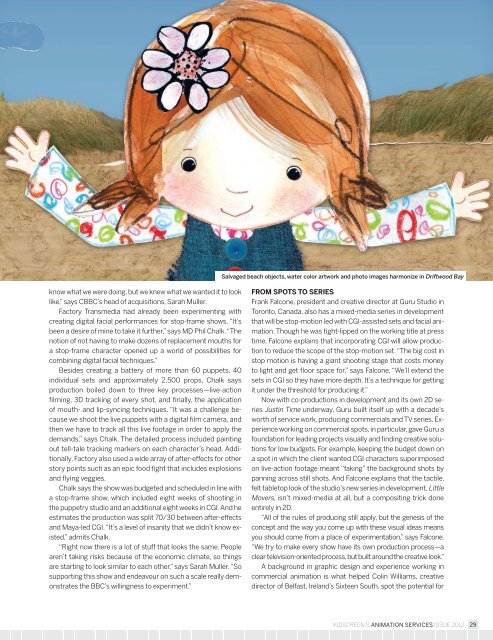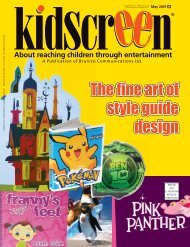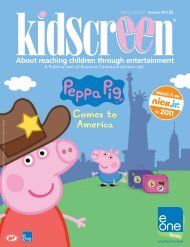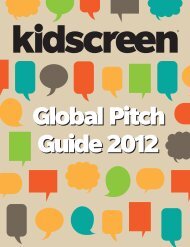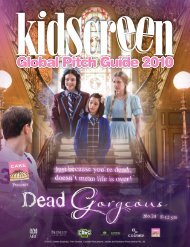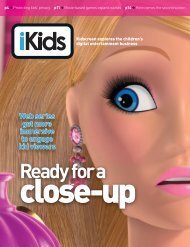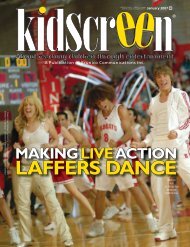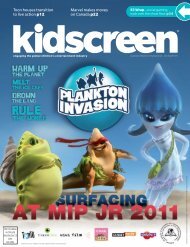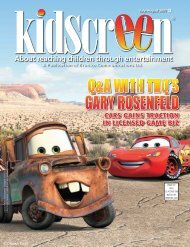rs ANIMATION SECIVRES CONTENTS - Kidscreen
rs ANIMATION SECIVRES CONTENTS - Kidscreen
rs ANIMATION SECIVRES CONTENTS - Kidscreen
You also want an ePaper? Increase the reach of your titles
YUMPU automatically turns print PDFs into web optimized ePapers that Google loves.
know what we were doing, but we knew what we wanted it to look<br />
like,” says CBBC’s head of acquisitions, Sarah Muller.<br />
Factory Transmedia had already been experimenting with<br />
creating digital facial performances for stop-frame shows. “It’s<br />
been a desire of mine to take it further,” says MD Phil Chalk. “The<br />
notion of not having to make dozens of replacement mouths for<br />
a stop-frame character opened up a world of possibilities for<br />
combining digital facial techniques.”<br />
Besides creating a battery of more than 60 puppets, 40<br />
individual sets and approximately 2,500 props, Chalk says<br />
production boiled down to three key processes—live-action<br />
fi lming, 3D tracking of every shot, and fi nally, the application<br />
of mouth- and lip-syncing techniques. “It was a challenge because<br />
we shoot the live puppets with a digital fi lm camera, and<br />
then we have to track all this live footage in order to apply the<br />
demands,” says Chalk. The detailed process included painting<br />
out tell-tale tracking marke<strong>rs</strong> on each character’s head. Additionally,<br />
Factory also used a wide array of after-effects for other<br />
story points such as an epic food fi ght that includes explosions<br />
and fl ying veggies.<br />
Chalk says the show was budgeted and scheduled in line with<br />
a stop-frame show, which included eight weeks of shooting in<br />
the puppetry studio and an additional eight weeks in CGI. And he<br />
estimates the production was split 70/30 between after-effects<br />
and Maya-led CGI. “It’s a level of insanity that we didn’t know existed,”<br />
admits Chalk.<br />
“Right now there is a lot of stuff that looks the same. People<br />
aren’t taking risks because of the economic climate, so things<br />
are starting to look similar to each other,” says Sarah Muller. “So<br />
supporting this show and endeavour on such a scale really demonstrates<br />
the BBC’s willingness to experiment.”<br />
Salvaged beach objects, water color artwork and photo images harmonize in Driftwood Bay<br />
FROM SPOTS TO SERIES<br />
Frank Falcone, president and creative director at Guru Studio in<br />
Toronto, Canada, also has a mixed-media series in development<br />
that will be stop-motion led with CGI-assisted sets and facial animation.<br />
Though he was tight-lipped on the working title at press<br />
time, Falcone explains that incorporating CGI will allow production<br />
to reduce the scope of the stop-motion set. “The big cost in<br />
stop motion is having a giant shooting stage that costs money<br />
to light and get fl oor space for,” says Falcone. “We’ll extend the<br />
sets in CGI so they have more depth. It’s a technique for getting<br />
it under the threshold for producing it.”<br />
Now with co-productions in development and its own 2D series<br />
Justin Time underway, Guru built itself up with a decade’s<br />
worth of service work, producing commercials and TV series. Experience<br />
working on commercial spots, in particular, gave Guru a<br />
foundation for leading projects visually and fi nding creative solutions<br />
for low budgets. For example, keeping the budget down on<br />
a spot in which the client wanted CGI characte<strong>rs</strong> superimposed<br />
on live-action footage meant “faking” the background shots by<br />
panning across still shots. And Falcone explains that the tactile,<br />
felt tabletop look of the studio’s new series in development, Little<br />
Move<strong>rs</strong>, isn’t mixed-media at all, but a compositing trick done<br />
entirely in 2D.<br />
“All of the rules of producing still apply, but the genesis of the<br />
concept and the way you come up with these visual ideas means<br />
you should come from a place of experimentation,” says Falcone.<br />
“We try to make every show have its own production process—a<br />
clear television-oriented process, but built around the creative look.”<br />
A background in graphic design and experience working in<br />
commercial animation is what helped Colin Williams, creative<br />
director of Belfast, Ireland’s Sixteen South, spot the potential for<br />
KIDSCREEN’S <strong>ANIMATION</strong> SERVICES ISSUE 2012 29


